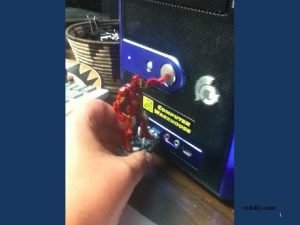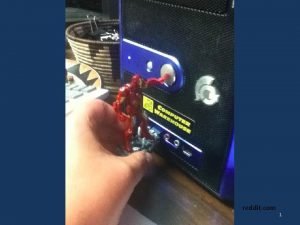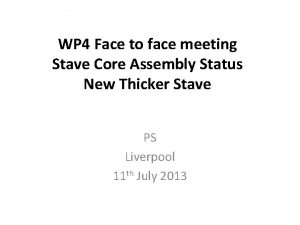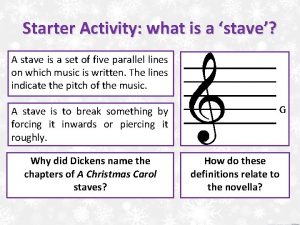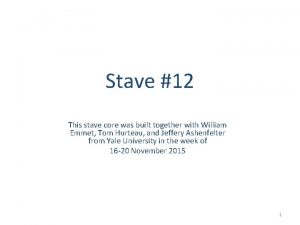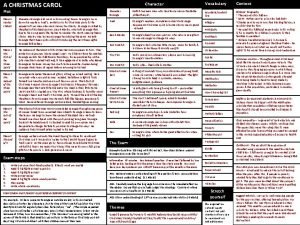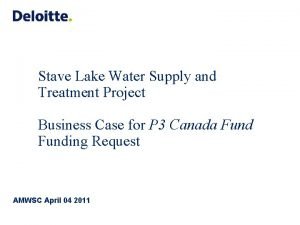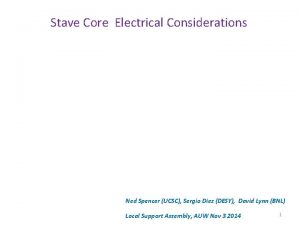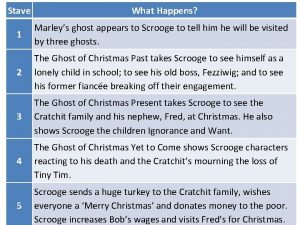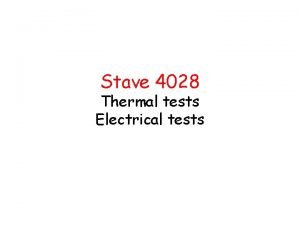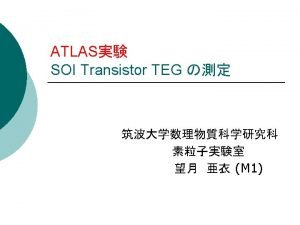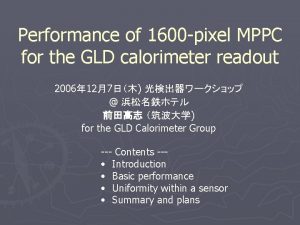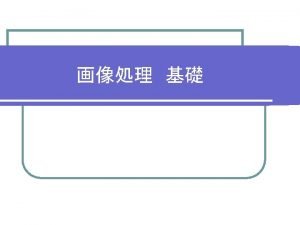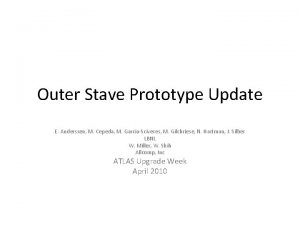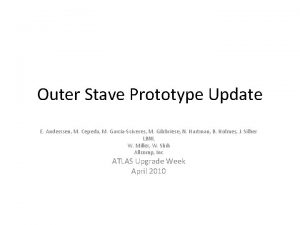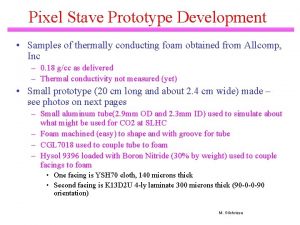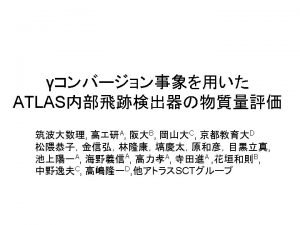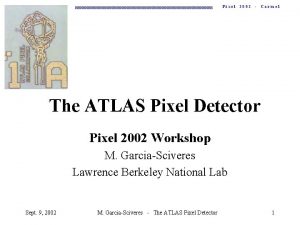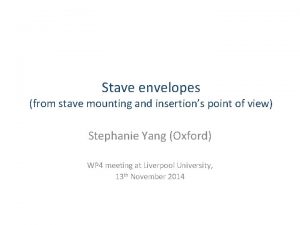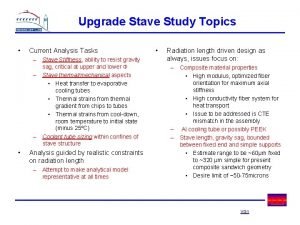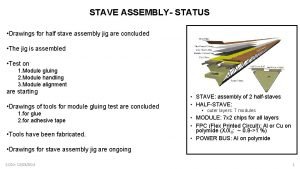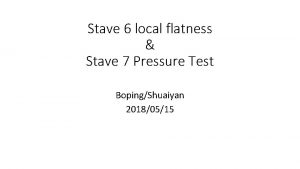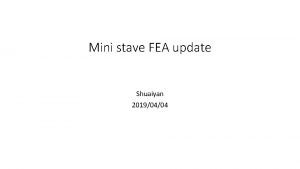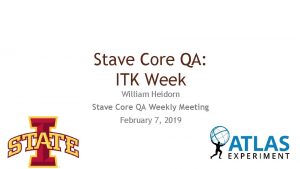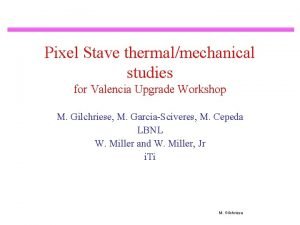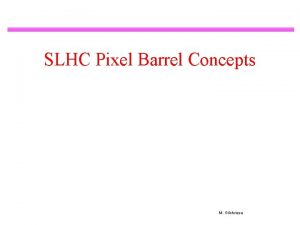Thermal Tests of Outer Pixel Stave Prototype Mark































- Slides: 31

Thermal Tests of Outer Pixel Stave Prototype Mark Convery(SLAC), Marco Oriunno (SLAC), Murdock Gilchries(LBNL), Bill Miller(ITI) 29 Sep 09 Thermal Tests of Outer Staves 1

Outer Pixel Stave Design • Two options for cable connection to modules – Cable on top/bottom of stave – Cable buried in stave. Cable ( 0. 5 mm thick) buried in foam Detailed layout of prototype cable underway • Buried cable preferred due to better thermal performance • Current prototype is “unburied” design 29 Sep 09 Thermal Tests of Outer Staves 2

Outer Stave Prototype • Built by Allcomp, Inc and LBNL • Platinum on silicon heaters used to simulate thermal load 29 Sep 09 Thermal Tests of Outer Staves 3

Water Cooling Tests at LBNL • Room termperature H 20 at 1 l/min • Temperature measured using IR imaging • Heat load corresponds to nominal LHC conditions 29 Sep 09 Thermal Tests of Outer Staves 4

SLAC CO 2 Blown System 29 Sep 09 Thermal Tests of Outer Staves 5

A B 21 o. C, 58 bar -10 o. C, 58 bar Pre-cooling C -37 o. C, 11 bar D E F 80 W G 29 Sep 09 Thermal Tests of Outer Staves 6

Evaporation Temperature Pressure Transmitter Drucker 7500 Tee Swagelok ¼” Pt 100 Temp sensor 29 Sep 09 Thermal Tests of Outer Staves 7

Stave Gas Connections • High pressure fittings needed for running with CO 2 • Insulated “cold box” used to minimize convection and heat loss SSteel Tube brazed on ID tube 2. 2 mm, wall thickness 300 um 29 Sep 09 Thermal Tests of Outer Staves modified Swagelok fitting 8

• PT 100 RTD’s glued to platinum-on-silicon heaters • Heaters connected in serial. Two circuits on top, two circuits on bottom • For initial data, only power top heaters 29 Sep 09 1200 mm Stave Electrical Connections Thermal Tests of Outer Staves 9

Labview Controls • National Instruments Compact. DAQ system • 20 channels of RTD readout • 32 multi-purpose (pressure, flow, etc. ) 29 Sep 09 Thermal Tests of Outer Staves 10

Run with the blow system Typical Run Temp. profile @100 W Temp. profile @80 W Induced dry out o. C dry out 100 W mf =2. 65 g/s mf =1. 7 g/s 80 W No power mf =1. 16 g/s mf 09 =1. 4 g/s 29 Sep mf =0. 2 g/s mf =0. 64 g/s Thermal Tests of Outer Staves Time 11

DT Measurements • Measurements taken at 80 (nominal power) and 100 Watts • Measure DT for each of 12 heaters Mass flow 1. 4 g/s Average DT=13 o. C Tfluid Mass flow 1. 16 g/s DT=11 o. C 29 Sep 09 Thermal Tests of Outer Staves Average Tfluid Teva p 12

CO 2/H 20 Comparisons • Ts-Tfluid = (Ts-Tw) + (Tw-Tfluid) • (Tw-Tfluid)=Q/h. A • h taken from Forced Convection Correlations – For H 20, h = 16347 W/m 2 K – For CO 2 at 80 W, h = 6800 W/m 2 K (DTfluid = 1. 9 C) – For CO 2 at 100 W, h = 7400 W/m 2 K (DTfluid=1. 5 C) • Define Thermal Impedance, R = (Tsurface-Twall)/Q • Good agreement between H 2 O and CO 2. • Confirms that R is independent of CO 2@80 W CO 2@100 W H 20 with IR imaging – Fluid – Temperature – Power 29 Sep 09 Thermal Tests of Outer Staves 13

Dry Out Studies Decreasing the mass flow we forced a dry out with a 0. 2 g/s temperature runaway at the end of the stave 0. 4 g/s 0. 6 g/s 29 Sep 09 Thermal Tests of Outer Staves 14

Pre-cooling loss 18 o. C, 54 bar -37 o. C, 11 barc 29 Sep 09 80 W Thermal Tests of Outer Staves 15

Updated Measurements • Have recently improved measurements to include – Heating both sides simultaneously – Measuring T on both sides – Measuring evaporation temperature directly • Analysis and improvements still underway – data preliminary 29 Sep 09 Thermal Tests of Outer Staves 16

Two Sides Measurements T 0 T 2 Top T 4 B 3 B 0 T 6 B 5 T 8 B 7 T 9 Bottom T 10 B 10 Six separate Heat Loads applied : 80 watts top 80 watts bottom 80 watts top + bottom (nominal load) 100 watts top 100 watts bottom 100 watts top + bottom (1. 25 x nominal) 29 Sep 09 Thermal Tests of Outer Staves 17

Two Sides Measurements Only top face Only top and only bottom on the same graph Temp. on the tube inside the box Temp. inside the tube, out of the box Power on on both face at the same time 29 Sep 09 Thermal Tests of Outer Staves 18

Finite Element Model (M. Oriunno) 4 cm Cable, 0. 174 Glue, Si, 0. 05 Glue, 0. 5 CF, 0. 10. 5 m Glue, 0. 25 m 0. 075 Foam, 4. 8 SSteel Tube ID 2. 2, th. 0. 3 Glue, 0. 1 1 m 29 Sep 09 Thermal Tests of Outer Staves 19

Materials and geometry Thickness (mm) Foam K (W/m. K) Heat flux W/cm 2 HTC W/m 2. K Water@84 W 0. 42 16347 4. 8 20 ID 2. 2, th. 0. 3 16 CO 2@100 W 0. 49 7800 0. 1 0. 4 CO 2@80 W 0. 44 6400 Glue Foam-facing 0. 075 0. 5 CF Facing 0. 27 Kx, 294/Kz, 1 Glue Facing-Sensor 0. 1 0. 8 Sensor 0. 5 148 Glue Sensor-Cable 0. 05 0. 8 Cable 0. 174 Kx, 90/Kz, 0. 3 Tube SSteel Glue tube-Foam HTC water from Dittus-Boelter correlation HTC CO 2 from Kandlikar with Ff=1. 75 Heat load case studied corresponding to the experimental measurements available: -Water at 20 o. C, Power 84 W 2 -phase Carbon dioxide evap. -37 o. C, Power 84 W o. C, Power 100 W evap. 29 Sep 092 -phase Carbon dioxide Thermal Tests-35 of Outer Staves 20

FEA Parameters Materials and geometry Thickness (mm) Foam 4. 8 20 ID 2. 2, th. 0. 3 16 0. 1 0. 4 Glue Foam-facing 0. 075 0. 5 CF Facing 0. 27 Kx, 294/Kz, 1 Glue Facing-Sensor 0. 1 0. 8 Sensor 0. 5 148 Glue Sensor-Cable 0. 05 0. 8 Cable 0. 174 Kx, 90/Kz, 0. 3 Tube SSteel Glue tube-Foam Heat flux W/cm 2 HTC W/m 2. K Water@84 W 0. 42 16347 CO 2@100 W 0. 49 7800 CO 2@80 W 0. 44 6400 K (W/m. K) HTC water from Dittus-Boelter correlation HTC CO 2 from Kandlikar with Ff=1. 75 Heat load case studied corresponding to the experimental measurements available: -Water at 20 o. C, Power 84 W 2 -phase Carbon dioxide evap. -37 o. C, Power 84 W 2 -phase Carbon dioxide evap. -35 o. C, Power 100 W 29 Sep 09 Thermal Tests of Outer Staves 21

FEA Results Water@RT, 84 watt CO 2@-37 o. C, 84 watt CO 2@-35 o. C, 100 watt 29 Sep 09 Thermal Tests of Outer Staves 22

Asymmetry due to the staggering in zee The power has been applied only on one face of the stave and, in reason of the staggered geometry, the heat flow path from the sensor to the tube spreads beyond the zee length of the sensors. The temperature drop in the fluid is not constant with a bell-shape distribution. Considering the average value, the effective length to be used in the calculation is: Leff = Qs/(h. p. D. DTavg) Which gives a value of 75 mm = 1. 75 x sensor length Heat Flow Path Temperature distribution 29 Sep 09 Thermal Tests of Outer Staves Temperature profile along the tube (zee) Temperature map along the tube 23

Summary of the experimental results with water, CO 2 and comparison with the FE simulations FEA Heat flux W/cm 2 Ts FEA TS exp. DT fluid FEA DT fluid Exp T fluid HTC W/m 2. K Water@84 W 0. 42 29. 2 28. 94 0. 81 0. 89 20 16347 CO 2@100 W 0. 49 -22. 87 -22. 32 2. 00 2. 06 -35 7800 CO 2@80 W 0. 44 -26. 9 -26. 47 1. 91 2. 00 -37 6400 All the above results are being collect in a Technical Note 29 Sep 09 Thermal Tests of Outer Staves 24

FEA Study (W. Miller) K 13 D 2 U facings 0/90/0 (0. 2 mm) Cable 0. 174 mm K 13 D 2 U facings 0/90/0 (0. 2 mm) 0. 174 mm K 5 Cable Allcomp foam Cable 0. 174 mm K 5 Allcomp foam Aluminum tube-2. 8 mm K 5 Allcomp foam Aluminum at tube-2. 8 mm Al close-outs each end Aluminum tube-2. 8 mm close-outs at each. Heaters end 12 Al Platinum on Silicon (0. 5 mm) Al close-outs at each end 12 Platinum on Silicon Heaters (0. 5 mm) (modeled at 0. 3 mm) Parameters differ some from Oriunno 29 Sep 09 Thermal Tests of Outer Staves 25

CFD Solution: One-sided Heating Fluid temperature rise =1. 16ºC H 2 Otest Cooling LBNL ΔT=1. 1ºC Fluid temperature rise =1. 16ºC LBNL test ΔT=1. 1ºC Flow Film coefficient solved by CFD 29 Sep 09 Thermal Tests of Outer Staves 26

Comparison with LBNL H 2 O Test Variation is < 1ºC Predicted and measured are “average” over heater surface Additional run time and increased mesh density on CFD might improve curve 29 Sep 09 Thermal Tests of Outer Staves 27

Stave CO 2 Film Coefficient-Predicted Single-sided heating at 84 W and low quality—average estimate 7000 W/m 2 K used in FEA. Quality not known.

Stave Solution Assuming CO 2 Cooling Plot based on temperature at chip center Tinlet=-37ºC H=7000 W/m 2 K Edge temperature=-26. 87ºC Prediction does not include effect of potential ambient heating 83. 4 W Average Difference=1. 1º

Conclusions • First experimental results of a local supports cooled with CO 2 • The goal was to have an experimental measure of thermal impedance for the assembly with pipe-glue-foam and facing. The results are encouraging and look to be in the expectations • Finite Element Analysis are in agreement with measurements • Systematic study of HTC and pressure drops are the next step • The test stand is available to all the colleagues willing to perform CO 2 measurements • Closed-loop system is planned to be completed near the end of the year. 29 Sep 09 Thermal Tests of Outer Staves 30

Prototype Considerations • System is currently pressure-relieved at 30 bar. The highest possible pressure is about 75 bar. Any prototype should have fittings capable of supporting this. • The heater power supplies that we use are 0 -40 V, 0 -5 A. It would be easiest if the prototype can be heated with these • IF IR-imaging is desired, the prototype should be painted with IR paint. 29 Sep 09 Thermal Tests of Outer Staves 31
 Prototype 2 reddit
Prototype 2 reddit Prototype 1 vs 2 reddit
Prototype 1 vs 2 reddit Ace different iq tests still make
Ace different iq tests still make Bussinador
Bussinador Thermal transfer vs direct thermal printing
Thermal transfer vs direct thermal printing Section 3 using thermal energy worksheet answer key
Section 3 using thermal energy worksheet answer key What is a stave in literature
What is a stave in literature Tell me i may sponge away the writing on this stone
Tell me i may sponge away the writing on this stone Stave face
Stave face Christmas carol stave 1 summary
Christmas carol stave 1 summary Christmas carol stave 4 summary
Christmas carol stave 4 summary What is a stave
What is a stave Stave core
Stave core A christmas carol summary stave 1
A christmas carol summary stave 1 Stave lake water level
Stave lake water level Electrical stave
Electrical stave Stave 5 a christmas carol
Stave 5 a christmas carol Bob cratchit quotes
Bob cratchit quotes Electrical stave
Electrical stave Pixel assignment
Pixel assignment Ellipse drawing algorithm in computer graphics ppt
Ellipse drawing algorithm in computer graphics ppt Rbg pixel
Rbg pixel Pixel aspect ratio
Pixel aspect ratio 32*32 pixel image
32*32 pixel image Performance pixel
Performance pixel Graphic text
Graphic text Pix for d
Pix for d Pixel counter
Pixel counter Pixel. com
Pixel. com Motoyoshi
Motoyoshi A pixel is not a little square
A pixel is not a little square Pixel mimosa
Pixel mimosa
